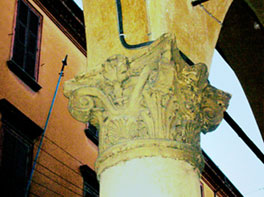|
BED AND BREAKFAST IN BOLOGNA ACCOMMODATION IN BOLOGNA ERBORISTERIA WEBMASTER |
||||||
|
|
During the years of the counter-Reformation Renaissance
embellishments were still being carried out with the opening of
the square and the building of the Fountian
of Neptune, the work of a Palermitan architect and a Flemish sculptor. From 1564 to 1566 Neptune Square, between King Enzo's
Palace and the Municipal Palace, was opened; it got its name from the
statue, the work of the Flemish sculptor Jean Boulogne de Douai
(Giambologna) placed on the fountain designed by a Palermitan
architectTommaso Laureti. The nearby Municipal Palace was the residence of
the Cardinal Legate who lived in the rooms on the second floor where now
the Collection of Municipal Art is. During this period on the side of the
Municipal Palace towards the square, and near the "Virgin with Child", a
terracotta by Nicolo dell' Area, was also placed the statue of Pope
Gregory XIII, the work of Alessandro Menganti. ln
the churches and in the "palazzi" (squares) of the town the works of art
were constantly increasing. In the church of St. Maria dei Servi the
marble ancon by Angelo Montorsi was placed. At present in the Natinal
Picture Gallery the 16th Century paintings of the city are exhibited,
surrounding the "Santa Cecilia" by Raffaello. These are the masterpieces
of Giulio Romano, Giorgio Vasari, the Parmigianino, Lorenzo Costa, the
Garofalo. |
|
b u |
|||
|
General - Environment - Iron and Etruscan Age - Roman Age - Patron Saint- The Commune - Alma mater studiorum - Re Enzo - Porticoes - St Peter - Gothic - 14th Century - Piazza Maggiore - Aristocratic palaces - Brick and other stones - Early 15th Century - Archiginnasio - Counter Reformation Renaissance - 16th Century - Great portico ribbons - Frescoes in palaces - The "scenographic" city - Napoleon's republics - Fall of Church power - The Restoration - Haussmann style - The new Century - Floreal style - Rationalism - World War - Active preservation - Around 2000 |
||||||
